Are you thinking of learning how to play an electric guitar? Good decision!
But before you start there are a few stumbling blocks along the way, for instance, which guitar do you learn to play first? Is it easier to start with an electric guitar or should you learn on an acoustic guitar? You will find a lot of contradictory answers. But, remember one thing, there is no wrong answer.
Music is about passion, it’s about what your soul tells you and how your heart guides you.Don’t look back, let the music come out naturally and feel each chord as you learn and improve on yourself.
Learning On an Electric Guitar
Let’s look at a few reasons why you should choose an electric guitar as your first instrument when you decide to learn how to play.
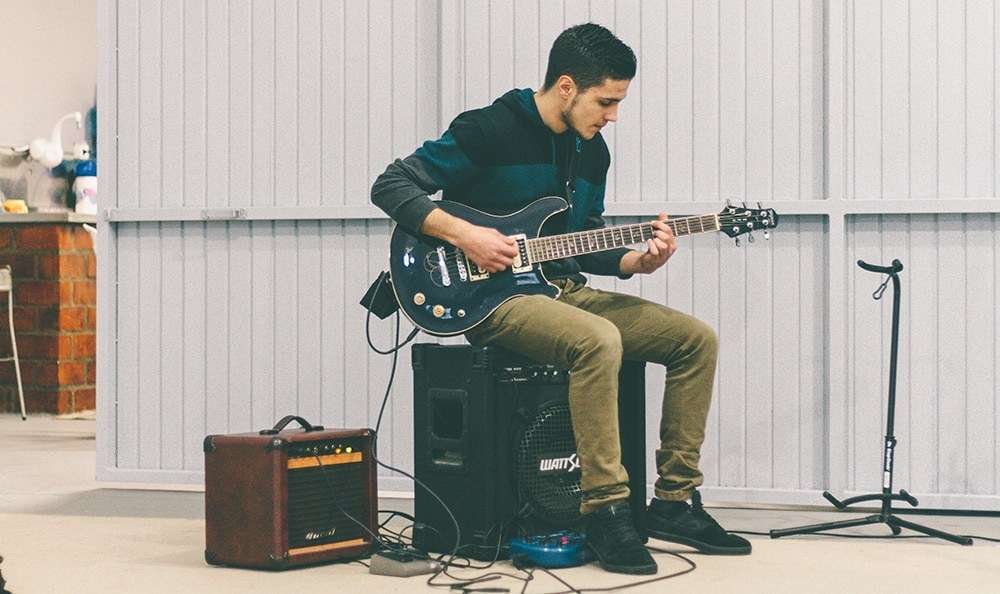
- Electric guitars are a bit easier to play when compared to acoustic guitars. In fact, some people believe it can take you 10,000 hours to master an acoustic guitar. Electric guitars do not require so many hours.
- You can practice at the volume you want, electric guitars allow you to control volume.
- There are a number of sound options you can experiment with.
- The musical choices with an electric guitar are much wider.
Electric vs Acoustic
Electric guitars are generally easier to play than acoustic guitars. This is because the strings are a bit lighter and you will find that the neck of an electric guitar is a bit thinner compared to the neck of an acoustic.
So for hands that are not used to fretting chords, it will make things more comfortable. In turn that will work to your advantage, because new players usually quit when they find the mechanics difficult to deal with.
When it comes to handling, they both work the same way since they weigh about 6 pounds each. However, some may be heavier based on size and material.
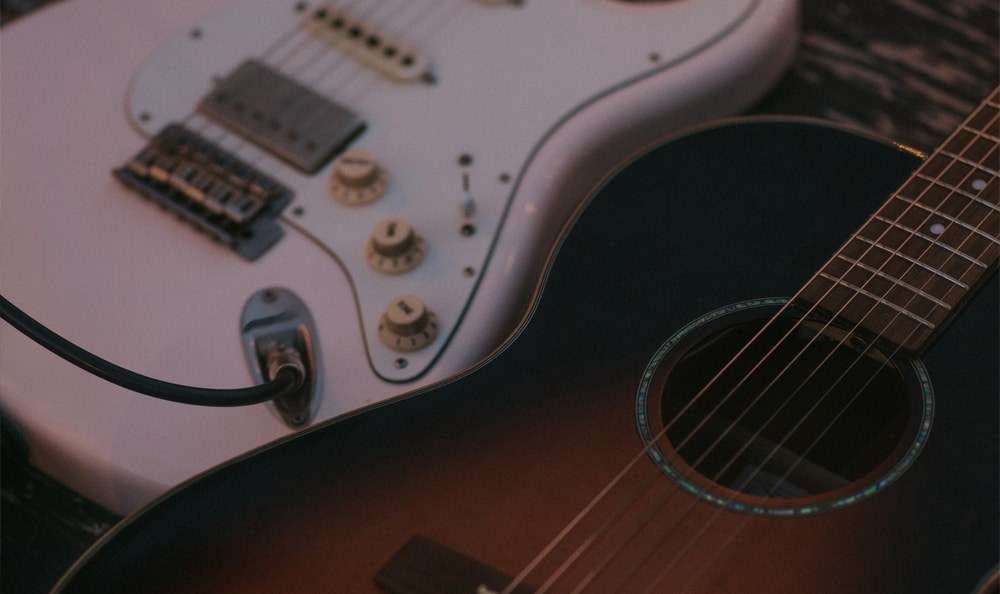
Volume Control
Electric guitars are louder than acoustic guitars. They have amps that will allow you to control the volume, which means you do not have to be loud at all times.
Additionally, beginner amps also have headphone jacks which let you practice in silence. On a lighter note, the ability to make mistakes which no one can listen to can be a plus as well.
Sound Options
It will take you a while to play like a professional. However, the array of amps and effects available on an electric guitar make things easier. You’d be able to play well without requiring hours of hard work.
Musical Choices
It takes a bit of time to understand what kind of music you really love and what you are really good at. Once you have figured that out, you’ll fly.
Electric guitars give you that freedom to explore all the options and decide what works best for you.
For example, you can start with strumming chords and move to classical jazz or metal.
The wide range of choices and ease to play can be an important factor.
How To Play an Electric Guitar: Getting Started
A mix of interest and desire is all it takes. You’re reading this article probably because you have passion, that’s the first thing.
Now, all you need is a bit of a push in the right direction and you’ll be on your way to becoming a guitarist.
It might all seem very intimidating at first, but don’t worry. It is natural to be scared before trying something new. We’ll answer all your questions and give you all the tips you need to be a pro:
You're never too old or too young to learn
Whether you are in your teens or well into your 40s, remember that there is no age restriction on learning a new skill.
It doesn’t matter when you start to play, playing an electric guitar is rewarding in itself and as long as it makes you feel good about life.
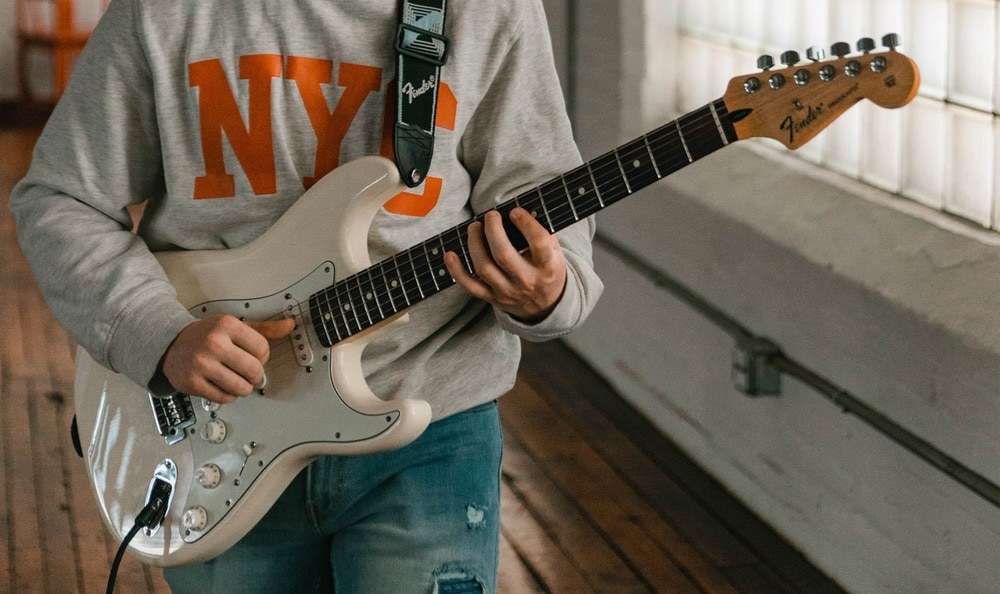
Learning to play guitar will enhance your self-discipline, coordination, confidence, and last but not the least, your creativity. You will begin to see things differently and notice a positive change in your lifestyle.
However, age does have an impact on things. Adults tend to practice more consistently. Experts believe it’s because they tend to be more motivated and dedicated than teens or younger players. Plus, how much free time you have can also impact the pace
Ready To Play? What’s the First Step?
Choosing the right learning style can go a long way in how good an electric guitarist you can become.
For instance, you need to decide whether you need a private instructor for your guitar lessons or you’d be more comfortable with online lessons.
There are plenty of options out there. Choosing the right mode of instruction is an important first step, which will develop good playing habits.
The right option depends on several factors including your budget and schedule. Online lectures offer flexibility as you can watch videos and listen to lectures whenever you’re comfortable. However, they often lack direct communication which can be very important when it comes to learning guitar.
On the other hand, going to a music class or taking private lessons can be very expensive but you will get immediate feedback.
How to Play an Electric Guitar: Learning the Basics
However you choose to learn, you should be aware of the basics of an electric guitar and why it needs to be your first instrument of choice.
Electric guitars tend to have thinner strings due to which they require less hand strength, which makes them a good choice for beginners.
They also have slimmer necks which makes it easier for players to grip them.
Strings for Beginners
As a beginner, you will want to start your lessons using lighter string gauge, the reason behind this is because thinner strings will produce less tension which is why they will be easier to work with.
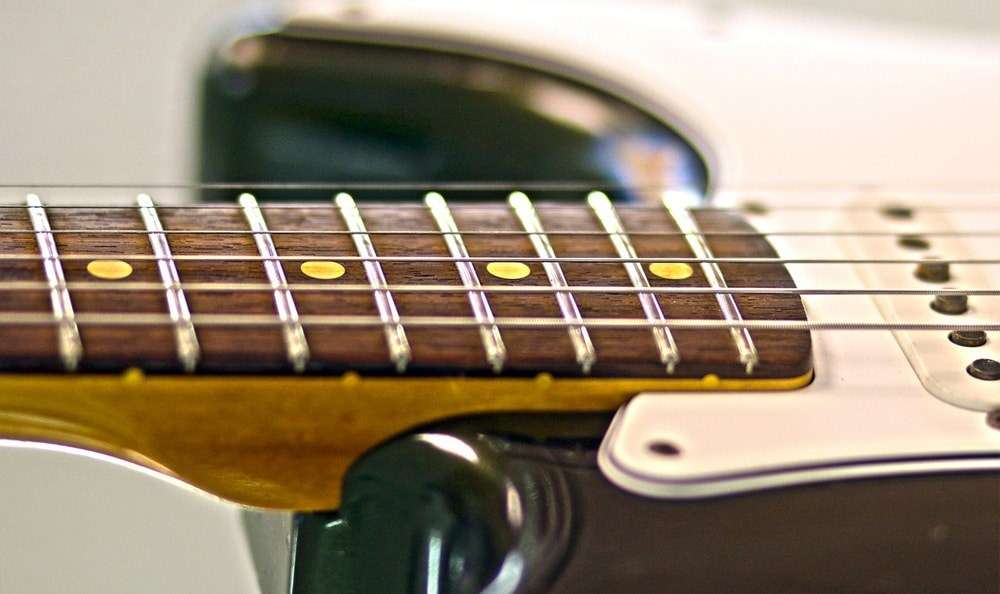
It is best to use a set of strings with a gauge between .009 inches to .042 inches or you might find it easier to begin with .010 inches to .046 inches – these are commonly referred to as nines or 10s.
Different materials also have different benefits which in turn have an effect on the tones they produce.
What Other Equipment Do You Need?
It is very important to be careful about the accessories and equipment required to play an electric guitar.
As time goes by and you become a more mature player, you can add more electric guitar accessories to your arsenal. For now, let’s stick to the basics.
Guitar Picks
Nothing is more confusing than trying to select the right kind of pick, the kinds and types that you will find at the music store with baffle you.
There are types based on shape, size, and thickness, and as you progress and become more of an expert you will stick to a type that suits your style.
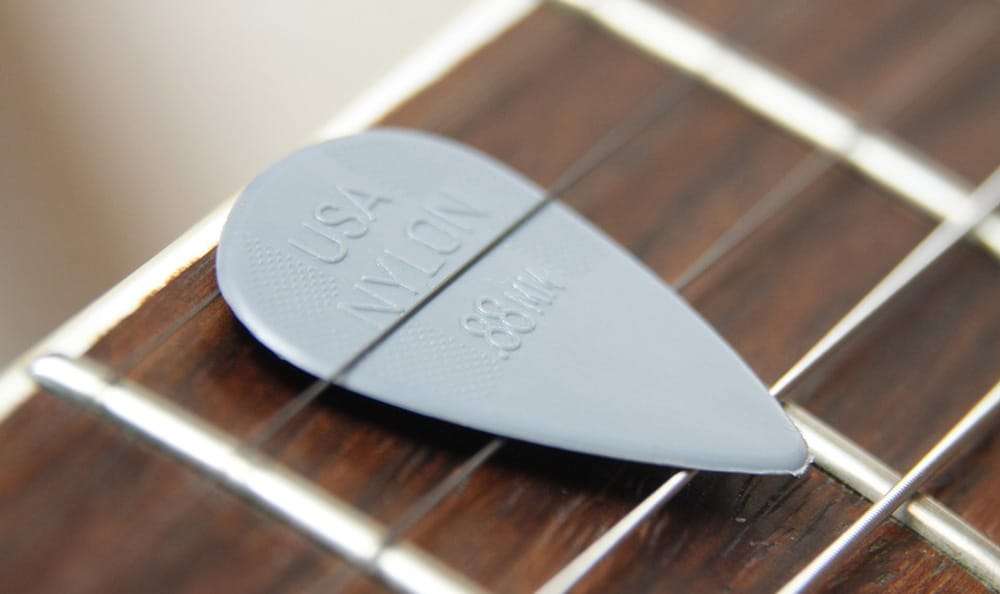
Generally speaking, plastic picks are a popular choice because of their grip and flexibility. As far as thickness goes, it depends on your grip comfort; as a rule of thumb, you should opt for a pick that is between .73 mm to .88 mm thick.
Strap
A good strap will come in handy if you are into playing your electric guitar while standing up. It is also essential in order to stabilize your instrument.
Again, you will find a multitude of straps each categorized into the kind of materials and design used to produce them. Always pick one that you are most comfortable with.
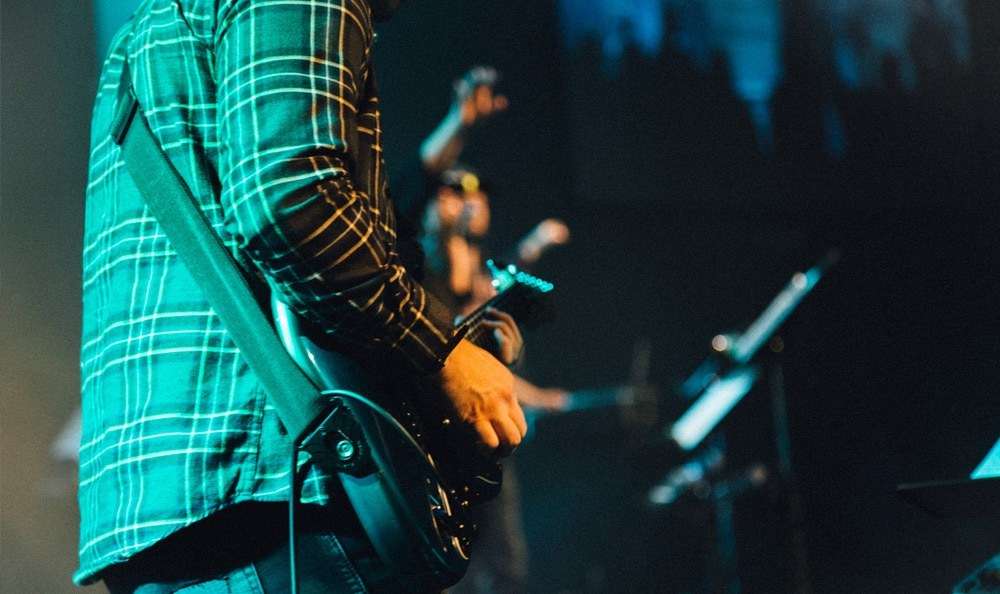
It is best to go for an option that is at least 2 inches wide with extra padding – called neoprene – around the neck and shoulder area.
Also, keep in mind that electric guitars have two endings to which you can attach your strap.
Cable
This is probably the most important tool in your guitar ensemble; a cable can easily make or break your tone.
The trick is to opt for an instrument cable which is shorter than 18.6 feet and has reinforced ends which in turn assure that there are minimal signal loss and handling noise.
Tuner
You will have to tune your guitar very often, hence it is best to choose a pitch pipe or an electronic tuner.
However, if you are looking for convenience as a beginner then you can go for a clip-on tuner which attaches itself to the headstock of your instrument and will tune through the vibration of your strings as you play on.
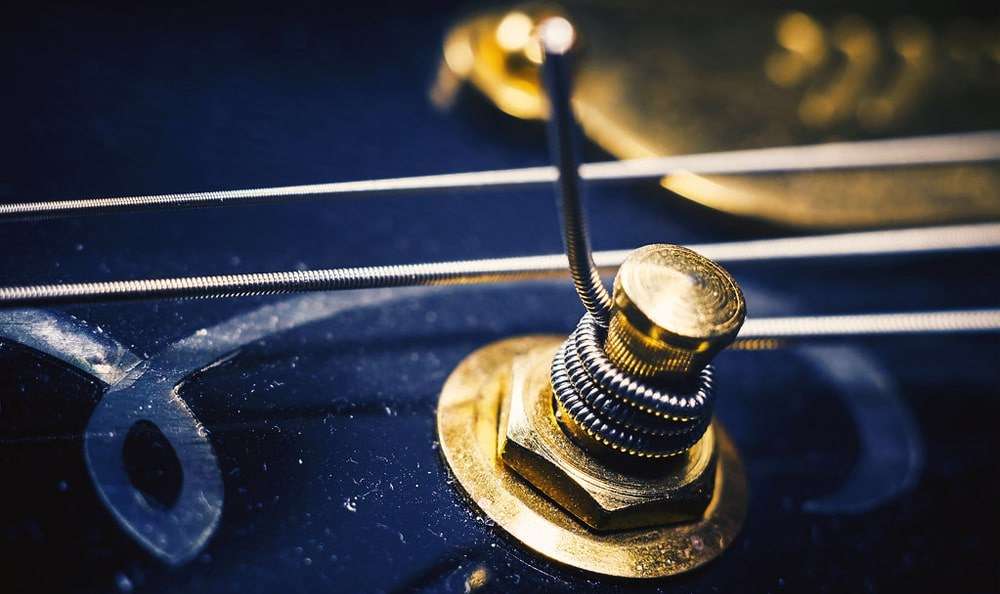
How to Properly Tune Your Guitar
To start with, your electric guitar can be tuned in a number of ways; it all depends on the style of music you play.
However, since you are still a beginner, let's focus on basic standard tuning. If you are using a tuner which has an LED display you will need to make sure that the needle is properly centered on the display.
While playing your electric guitar, adjust your tuning machines in line if your sound is sharp or falls flat.
The Difference between Barre and Open Chords
These are probably two terms which you will hear repeatedly as you move along and develop your practice. So, let’s tell you what they actually mean.
Once you start to learn the art of playing the guitar, you can pick the option that fits you more.
How to Play an Electric Guitar: Let’s Get Started
Now that you are on your way and already know a little about how to play an electric guitar, let's get right into it and look at the essentials in order to begin learning to play an electric guitar.
This is just a beginner’s guide on how to play an electric guitar, when you are on your way these pointers will be like second nature to you.
Buy the Essentials
For starters, there are a few things you will need. These include an electric guitar, a pick and a cable along with a small practice amp to begin with.
Additionally, choose a guitar tuner and a capo.
Learning the Ropes
Your electric guitar has different parts, but there are two things you need to keep in mind. Press and hold strings with your left hand while striking them with your right hand.
Remember, with an electric guitar you have a number of variables in play at any one time. Let’s look at those as well.
If the pickup selector is towards the neck of your guitar your tones will be warmer, if it is leaning away from the neck you will get a crisper tone.
Learning the Names and Numbers of Your Strings
This is vital, other than the essentials of your guitar you need to know your strings. The first tip is to learn how to read chord boxes and tabs on your electric guitar.
Secondly, you need to learn how these work when you are playing in a group of guitarists so communication with them is also very important.
From the thickest to the thinnest, electric guitar chords are placed in this format: E A D G B E. String numbers are usually right to left, from 1 to 6 and so one.
Learning Basic Chords
At the start you will usually only play simple chords like F or B. However, as you learn more, you will start to try your hand at other chords, too.
It is important to know your chords so you can play some difficult tones and enjoy versatility.
The Amp Tone
The amplifier is what sets the electric guitar apart from the acoustic guitar.In learning how to play an electric guitar, you will also need to learn how to use amplifiers. If you want to play your electric guitar without an amp it will be very quiet, hence it is best to spend a little more time in knowing amps.
To put it simply, the amplifiers are your electric guitar speakers, you plug your guitar to them and it makes a sound by amplifying the electric signal from your guitar. It’s important to learn how to use amplifiers because it’s more enjoyable to play an electric guitar with them, good or bad, you will always have room to improve on your technique.
All amps have different channels; the clean channel is the pure tone that is received from your guitar to the speakers. Most amps also have other channels that produce a dirtier or more distorted tone.
Amps can also create guitar effects, but focus on the fundamentals first before you get to this. To get the best effect via your amp ensure that your guitar is always in tune.
Strum your Chords
If you want to be a great electric guitarist you will need to learn how to strum your chords in rhythm. It will take time to reach the perfection you want but right at the start remember to develop the right technique.
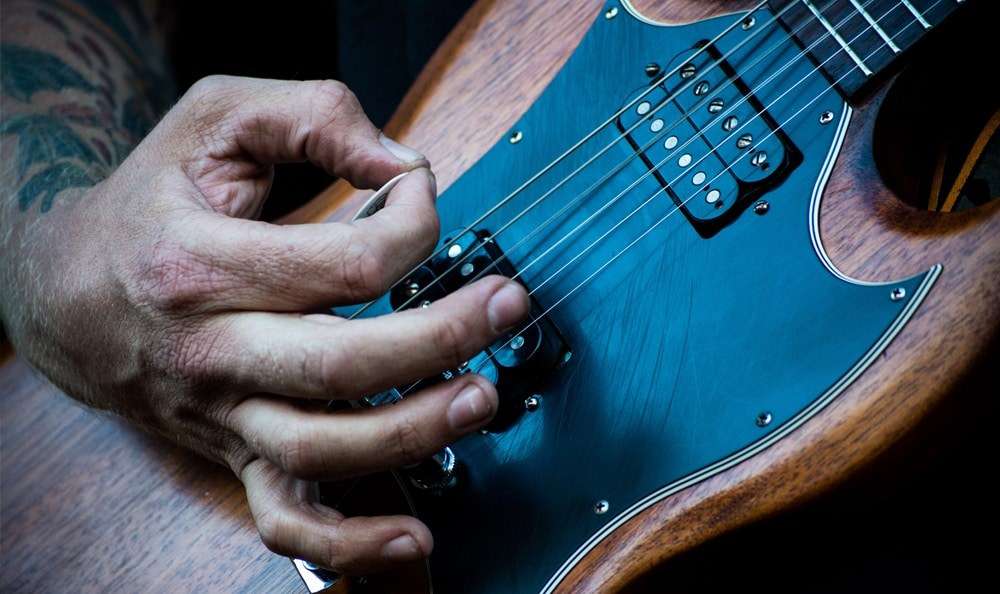
Start Learning Today
Well, that’s about it, we have covered almost all the essentials. But here is a bonus point, play the song you absolutely love and always keep doing that. You are likely to be more successful in honing your techniques if you do so and enjoy practicing your electric guitar at the same time as well.
Learning about how to play an electric guitar will never be enough. You must take lessons – online or offline – and start playing it to polish your skills.If you do not have a lot of time, start practicing for about 15 minutes a day and increase as you get more interested.
Good luck!
